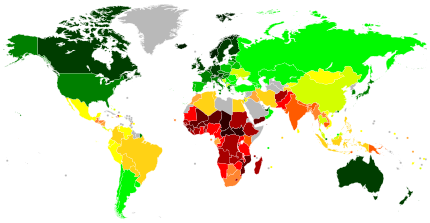List of countries by inequality-adjusted Human Development Index
According to the 2016 Report, "The IHDI can be interpreted as the level of human development when inequality is accounted for", whereas the Human Development Index itself, from which the IHDI is derived, is "an index of potential human development (or the maximum IHDI that could be achieved if there were no inequality)".
The index captures the HDI of the average (calculated using not arithmetic, but geometric mean) person in society, which is less than the aggregate HDI when there is inequality in the distribution of health, education and income.
The IHDI, estimated for the world and specific countries, captures the losses in human development due to inequality in health, education and income.
Losses in all three dimensions vary across countries, ranging from just a few percent (e.g. Czech Republic and Slovenia) up to over 40% (e.g. Angola and Comoros).
[3] The table below ranks countries according to their inequality-adjusted human development index (IHDI).

|
0.800–1.000 (very high)
0.700–0.799 (high)
0.550–0.699 (medium)
|
0.220–0.549 (low)
Data unavailable
|

|
0.900–0.910
0.850–0.899
0.800–0.849
0.750–0.799
0.700–0.749
0.650–0.699
|
0.600–0.649
0.550–0.599
0.500–0.549
0.450–0.499
0.400–0.449
|
0.350–0.399
0.300–0.349
0.250–0.299
0.222–0.249
Data unavailable
|